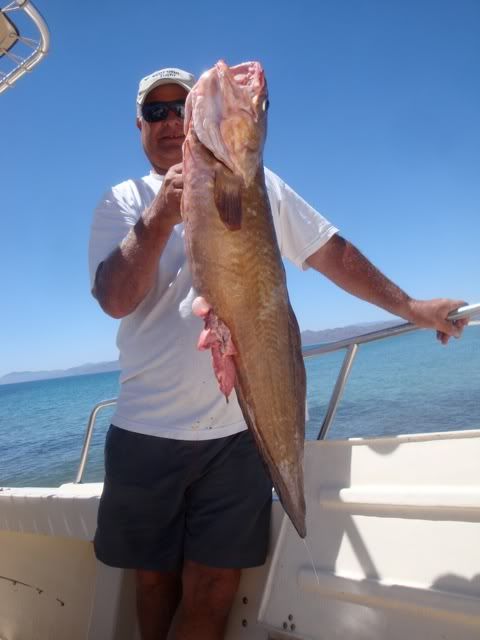Joelt
Nomad
 
Posts: 131
Registered: 8-27-2003
Location: Tahoe Nv.
Member Is Offline
|
|
Fish ID
Caught this at Wilbers hole near Mulege in early May. About 250 feet on a chrome and blue jig. The head looks like a bass with catfish like wiskers
and it seems to have been shorted a respectable tail. The fillets were thick and white and very good.

Joelt
|
|
|
htnfool
Nomad
 
Posts: 137
Registered: 3-27-2009
Location: Boise, Idaho/Mulege
Member Is Offline
Mood: Fishy
|
|
I have seen fish like that but never that HUGE.
it's a giant 'Pacific bearded BROTULA'.
Great catch by the way. Good to see wilburs kicking out something. I love that spot for yellows
[Edited on 6-1-2011 by htnfool]
|
|
|
Joelt
Nomad
 
Posts: 131
Registered: 8-27-2003
Location: Tahoe Nv.
Member Is Offline
|
|
Thanks htnfool. I have looked all over the place and have come up with nothing. Seems like 250 feet may be a little shallow for this fish. Maybe in
shallower water because of lack of food deeper? Or I read somewhere about the lack of oxygen in deeper water in the Sea of Cortez this year. It gave a
fight like a cabrilla the same size. Appreciate your help.
Joelt
|
|
|
Cisco
Ultra Nomad
    
Posts: 4196
Registered: 12-30-2010
Member Is Offline
|
|
"In Mexican fishing waters, the Pacific Bearded Brotula ranges from Magdalena Bay southwards along the Pacific side of the Baja California peninsula,
throughout the Sea of Cortez, and along the coast of the Mexican mainland south to Guatemala.
The Pacific Bearded Brotula is the only Cusk Eel found in Mexican waters that is larger than 18 inches. It feeds on polychaete worms, small
crustaceans, small clams and other invertebrates. It is seldom seen by humans and is of limited interest to most.
The catches shown are very rare by hook and line.
The Pacific Bearded Brotula is a member of the Bythitidae Family which are known in Mexico as brótulas vivíparas. They are long slender fishes with a
long dorsal fin that is normally continuous with the anal and dorsal fins. They have small eyes, no fin spines, and very small pelvic fins inserted
under the eyes or the gills. They bear their young alive.
The family has 96 species from 33 genera which are found in all types of marine habitats. The reef species live deep in cracks and crevices. A total
of seven members of the family live in Mexican waters."
|
|
|
Joelt
Nomad
 
Posts: 131
Registered: 8-27-2003
Location: Tahoe Nv.
Member Is Offline
|
|
Thanks Cisco. Good info. Doesn't sound like many are caught. Maybe it is some kind of record? Actually I could care less about a record. We had a
little get together and enjoyed the fish. Thanks again
Joelt
|
|
|
Cisco
Ultra Nomad
    
Posts: 4196
Registered: 12-30-2010
Member Is Offline
|
|
A twinge of meanness hit me initially;
YOU ATE IT!!!
MY GOWD MAN THAT FISH IS THE COELACANTH OF THE PACIFIC!
THERE HAS NEVER BEEN ANYTHING BUT FOSSIL RECORDS AND...YOU ATE IT!
but I was able to overcome that urge before I posted.
Since it is basically a shellfish feeder I bet it was really good too.
Cheers.
|
|
|
bacquito
Super Nomad
   
Posts: 1615
Registered: 3-6-2007
Member Is Offline
Mood: jubilado
|
|
Interesting, thanks all.
bacquito
|
|
|
4baja
Super Nomad
   
Posts: 1339
Registered: 9-4-2003
Location: morro bay ca
Member Is Offline
|
|
thats a gulf catfish and the meat is poisoness. are you all still alive?
|
|
|
baitcast
Super Nomad
   
Posts: 1785
Registered: 8-31-2003
Location: kingman AZ.
Member Is Offline
Mood: good
|
|
Little kool-ade and you could have had a real party
Rob
Anyone can catch fish in a boat but only \"El Pescador Grande\" can get them from the beach.
I hope when my time comes the old man will let me bring my rod and the water will be warm and clear.
|
|
|

